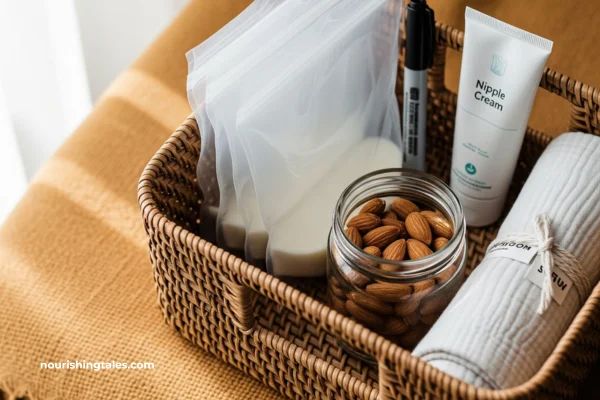Breastfeeding vs. pumping doesn’t have to be an overwhelming choice when you’ve just stepped into one of the biggest adventures of your life. We want you to know you’re doing an incredible job navigating this journey.
Right now, your world is probably a beautiful, chaotic mix of joy, sleepless nights, and a whole lot of advice. From your loving mother-in-law to that Instagram influencer, everyone seems to have an opinion on how you should be feeding your baby. It can feel like you’re being pushed to find the one “perfect” way.
Let’s press pause on all that noise for a moment.
Here’s the single most important truth: the best way to feed your baby is the way that keeps both you and your baby healthy and happy. Your mental well-being isn’t just a nice-to-have; it’s the foundation of your parenting journey. This guide is here to be your friend, walking you through your options without any judgment. There are no wrong answers here, only the choice that is right for your family.
The Journey of Direct Breastfeeding
This is the timeless act of nursing your baby directly at your breast. For many mums, it can be a deeply rewarding and beautiful experience.
What Mums Often Love About It
- A Unique Connection: That precious skin-to-skin contact during nursing releases oxytocin (the “love hormone”) for both you and your baby, building a powerful, unspoken bond.
- Perfectly Personalised Nutrition: Your breast milk is amazing! It literally changes to meet your baby’s needs, providing the right nutrients and even antibodies if your little one is feeling unwell.
- Convenience on Tap: Once you both get the hang of it, breastfeeding is incredibly convenient. There are no bottles to pack or parts to wash. Your milk is always ready, always warm, and always with you.
- Health Benefits for You: Nursing helps your uterus contract back to its pre-pregnancy size and is linked to a lower risk of certain health conditions for you later in life.
The Real-World Challenges
It’s so important to be honest about the fact that breastfeeding doesn’t always come easily. If you’re finding it tough, please know you are absolutely not alone.
- The Latch Can Be Tricky: A good latch is everything, but it can be hard to master. Things like tongue-ties or flat nipples can lead to sore, cracked nipples and a lot of tears (from both of you!).
- The “How Much?” Anxiety: One of the biggest worries for nursing mums is not knowing exactly how much milk their baby is getting. This can be especially stressful if there are any concerns about weight gain.
- It’s Physically Demanding: You are your baby’s entire source of food, 24/7. Cluster feeding and growth spurts can feel relentless, leaving you feeling touched-out and exhausted.
- You’re Always “On Call”: Being the only one who can feed the baby can feel isolating. Simple things like a trip to the market or getting a solid block of sleep suddenly become major logistical puzzles.
The Journey of Exclusive Pumping (EP-ing)
Exclusive Pumping is when you express your breast milk with a pump and feed your baby from a bottle. This path is a true labour of love, and EP-ing mums are some of the most dedicated parents we know.
The Powerful Advantages
- You Know Exactly How Much: Seeing the millilitres in the bottle can be incredibly reassuring. You have clear, visible proof that your baby is getting what they need.
- Sharing the Load: Pumping allows your partner, parents, or a caregiver to share the feeding duties. This gives you a much-needed break and helps them build their own beautiful bond with the baby.
- Freedom and Flexibility: While you’re committed to a pumping schedule, you’re not tied to every single feed. You can go to appointments or return to work knowing your baby is getting your milk.
- A Lifesaver for Latch Issues: For mums and babies who struggle with latching, pumping is a fantastic way to provide all the benefits of breast milk when nursing isn’t an option.
The Demanding Realities
Exclusive pumping is a serious commitment. Many mums say it feels like doing two full-time jobs: making the milk and feeding the baby.
- The Time Commitment: To establish and maintain your supply, you’ll need to pump every 2-3 hours around the clock, especially in the early months. This doesn’t even include the time spent bottle-feeding and washing up.
- The Endless Wash Cycle: The pile of pump parts and bottles in the sink can feel never-ending. We know how tiring it can be, which is why we created a simple guide on how to clean your pump parts to make this chore a little easier.
- Being Tethered to a Machine: Instead of being attached to a baby, you’re attached to a pump. It takes planning and dedication, and it’s important to remember that getting the fundamentals right—like ensuring you have the correct flange size can make your experience much more comfortable and effective.
- The Emotional Side: Some mums miss the bonding experience of nursing and can feel a sense of loss. It’s important to be intentional about creating those moments with plenty of cuddles and skin-to-skin time outside of feeds.
The Smart Path: Combination Feeding
Let’s be very clear: choosing to combination feed is not a compromise or a sign of failure. It is a brilliant, practical, and sustainable choice that lets you build a feeding plan that truly works for you.
Combination feeding simply means giving your baby both breast milk (nursed or pumped) and formula.
This can look different for every family. Maybe you nurse all day and your partner gives a bottle of formula at night so you can sleep. Perhaps you need to supplement while you work on increasing your milk supply. Or maybe you just want the flexibility of having formula as a backup for days when you feel exhausted.
Combination feeding can give you the best of both worlds. It eases the pressure of being the sole provider, gives you more freedom, and can actually help you breastfeed for longer by preventing burnout.
A Quick Side-by-Side Look
| Factor | Direct Breastfeeding | Exclusive Pumping | Combination Feeding |
| Convenience | High (no prep) once learned, but can be tricky in public initially. | Medium (requires equipment, but anyone can feed). | High (maximum options for any situation). |
| Flexibility for Mum | Low (mum must be present for all feeds). | Medium (tethered to a pump schedule, not every feed). | High (can choose when to breastfeed/use a bottle). |
| Partner Involvement | Low (can help with burping, nappy changes, etc.). | High (partner can take over entire feeds). | High (partner can manage all bottle feeds). |
| Cost | Low (nursing supplies are optional costs). | Medium-High (pump, bottles, parts, storage bags). | Medium (cost of formula + any pumping supplies). |
| Time Commitment | High (on-demand feeding can be constant). | Very High (time spent pumping + feeding + washing). | Varies (flexible; can be adjusted to your needs). |
Questions to Gently Ask Yourself
To find your path, tune out the noise and listen to your own heart. Grab a cup of chai, find a quiet corner, and reflect on these questions.
- What does my support system look like? Do I have a partner or family member who can help with bottle feeds? Is my workplace supportive of my feeding choices?
- What does my baby need right now? Are there any health concerns, like slow weight gain, that might influence my decision?
- What does my return-to-work plan look like? How will feeding fit into my work schedule? Thinking through the logistics can be a game-changer, and our complete guide to pumping at work can help you feel prepared.
- Most importantly: What feels best for my mental and physical health? Which scenario brings me the most peace and the least anxiety? Your well-being is essential. A happy, rested parent is the greatest gift you can give your child.
Your Journey, Your Choice
How you feed your baby is a deeply personal decision, and it’s one that can change over time. What works this week might not work next month, and that is more than okay. You have permission to adapt, to change your mind, and to forge a new path whenever you need to.
Whether you breastfeed for two years or two days, whether you pump around the clock or combination feed from day one—you are a phenomenal mother. You are nourishing your child with love and incredible strength.
Celebrate your journey, honour your efforts, and please, be gentle with yourself. You are doing an amazing job.
Disclaimer: This article is intended for informational purposes only and is not a substitute for professional medical advice, diagnosis, or treatment. Always seek the advice of your doctor, paediatrician, or another qualified health provider, such as an International Board Certified Lactation Consultant (IBCLC), with any questions you may have regarding a medical condition or the health and well-being of your baby.




